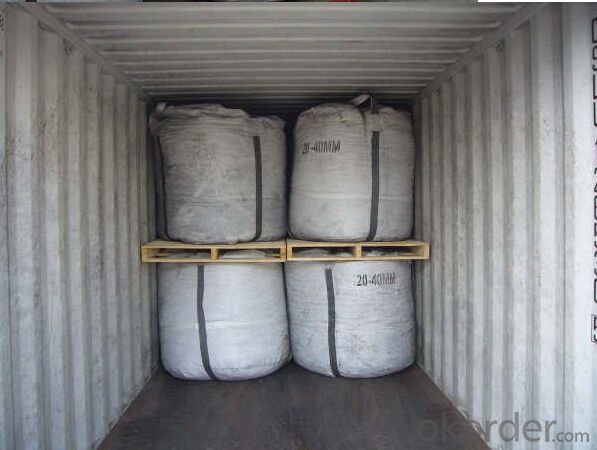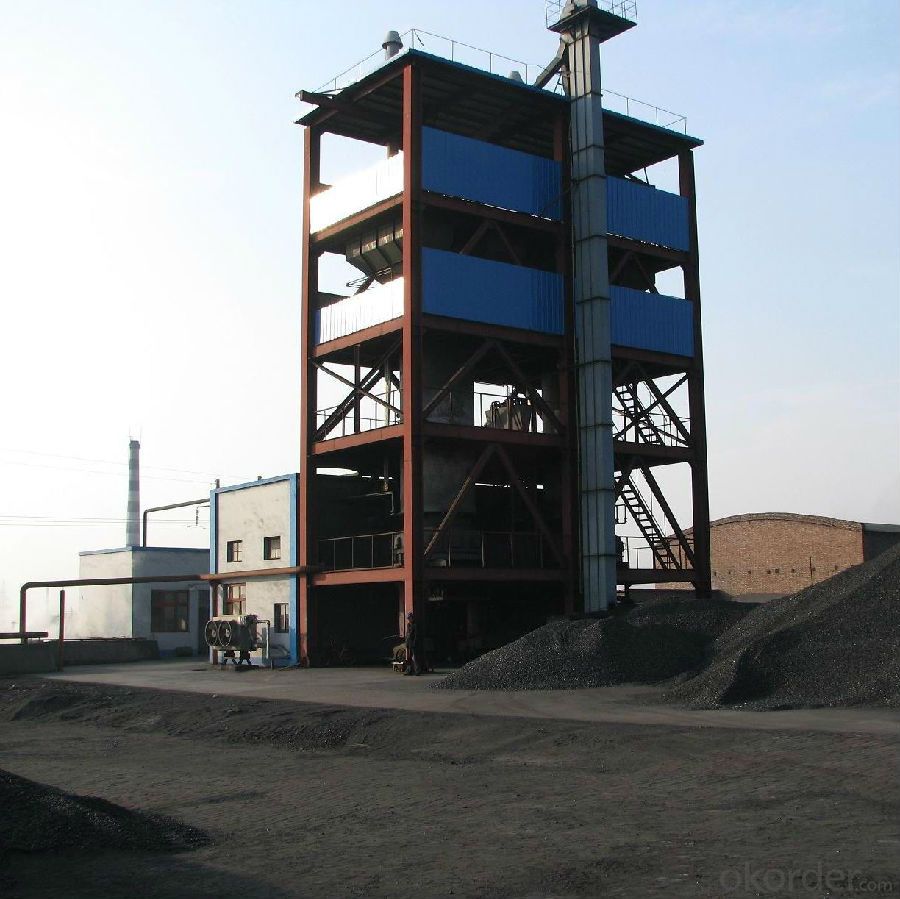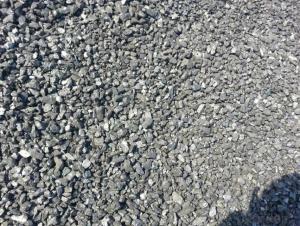Calcined Anthracite Coal with Fixed Carbon 90-95%
- Loading Port:
- Tianjin
- Payment Terms:
- TT OR LC
- Min Order Qty:
- 20 m.t.
- Supply Capability:
- 5000 m.t./month
OKorder Service Pledge
OKorder Financial Service
You Might Also Like
Packaging & Delivery
Calcined Anthracite Coal with Fixed Carbon 90-95%
25kgs/50kgs/1ton per bag or as buyer's request
Specifications
Calcined Anthracite Coal with Fixed Carbon 90-95%
Calcined Anthracite
Fixed carbon: 90%-95%
S: 0.5% max
Size: 0-3. 3-5.3-15 or as request
Product Advantage
Calcined Anthracite Coal with Fixed Carbon 90-95%
It used the high quality anthracite as raw materials through high temperature calcined at over 2000 by the DC electric calciner with results in eliminating the moisture and volatile matter from anthracite efficiently, improving the density and the electric conductivity and strengthening the mechanical strength and anti-oxidation. It has good characteristics with low ash, low resistvity, low sulphur, high carbon and high density. It is the best material for high quality carbon products.
Product Feature:
Calcined Anthracite Coal with Fixed Carbon 90-95%
| FC | 95 | 94 | 93 | 92 | 90 |
| ASH | 4 | 5 | 6 | 6.5 | 8.5 |
| V.M. | 1 | 1 | 1 | 1.5 | 1.5 |
| S | 0.3 | 0.3 | 0.3 | 0.35 | 0.35 |
| MOISTURE | 0.5 | 0.5 | 0.5 | 0.5 | 0.5 |
Pictures
Calcined Anthracite Coal with Fixed Carbon 90-95%



FAQ:
Calcined Anthracite Coal with Fixed Carbon 90-95%
What can we do?
1.High quality and competitive price.
2.Timely delivery.
3.If any item you like. Please contact us.
Your sincere inquiries are typically answered within 24 hours.
so-font-kerning: 0'>2.Timely delivery.
3.If any item you like. Please contact us.
Your sincere inquiries are typically answered within 24 hours.
- Q:What are the properties of carbon fibers?
- Carbon fibers possess a range of remarkable attributes, rendering them a distinctive and adaptable material. One noteworthy characteristic is their exceptional strength-to-weight ratio. Carbon fibers exhibit tremendous strength, often surpassing that of steel, while also being significantly lighter. This quality makes them exceptionally well-suited for industries such as aerospace and automotive, where high strength and low weight are essential. Another significant attribute of carbon fibers is their stiffness. They possess a high degree of rigidity, ensuring minimal deformation when subjected to applied loads. This property proves advantageous in applications that require stability and rigidity, such as the construction of sporting goods like tennis rackets or golf clubs. Additionally, carbon fibers display outstanding resistance to chemical corrosion. They exhibit a high level of resistance to the detrimental effects of chemicals or corrosive substances, making them highly suitable for use in harsh environments. Industries such as chemistry or offshore structures prefer carbon fibers due to this property. Furthermore, carbon fibers have a low thermal expansion coefficient, indicating minimal expansion when exposed to heat. This characteristic is vital in applications where thermal stability is crucial, such as the manufacturing of high-temperature components like turbine blades or heat shields. Moreover, carbon fibers possess excellent fatigue resistance, enabling them to endure repeated loading and unloading cycles without significant damage. This attribute is particularly advantageous in applications subjected to cyclic or dynamic stresses, including the construction of sports equipment or aerospace structures. Lastly, carbon fibers exhibit excellent electrical conductivity. They efficiently conduct electricity, making them suitable for applications that require electrical conductivity, such as lightning strike protection in the aerospace industry or the production of electronic devices. In summary, the high strength-to-weight ratio, stiffness, chemical resistance, low thermal expansion, fatigue resistance, and electrical conductivity of carbon fibers establish them as a highly sought-after material in various industries.
- Q:What are the applications of carbon nanomaterials in medicine?
- Carbon nanomaterials have a wide range of applications in medicine, including drug delivery systems, tissue engineering, biosensors, and imaging techniques. They offer unique properties such as high surface area, biocompatibility, and the ability to carry and release drugs in a controlled manner. Additionally, carbon nanomaterials can be used for targeted therapy, regenerative medicine, and diagnostic purposes, making them promising tools for advancing medical treatments and improving patient outcomes.
- Q:What are carbon credits and how do they work?
- Carbon credits are a market mechanism designed to reduce greenhouse gas emissions. They work by assigning a monetary value to each ton of carbon dioxide or other greenhouse gases that are not released into the atmosphere. This value is assigned through a process called carbon offsetting, which involves investments in projects that reduce emissions, such as renewable energy projects or reforestation initiatives. These projects generate carbon credits, which can be bought and sold by companies or individuals to offset their own emissions. By purchasing carbon credits, entities can effectively compensate for their own carbon footprint and contribute to global efforts in mitigating climate change.
- Q:What are the environmental impacts of carbon emissions from industries?
- The environmental impacts of carbon emissions from industries are significant and wide-ranging. Carbon emissions from industries contribute to the greenhouse effect, leading to global warming and climate change. This, in turn, results in rising temperatures, melting ice caps, and changing weather patterns, which can have devastating consequences for ecosystems, wildlife, and human populations. Additionally, carbon emissions contribute to air pollution, leading to respiratory problems and other health issues. Furthermore, the acidification of oceans due to carbon dioxide absorption harms marine life and coral reefs. Overall, the environmental impacts of carbon emissions from industries are substantial and necessitate urgent action to mitigate and reduce these emissions.
- Q:How is carbon used in the production of carbon nanowires?
- Carbon's unique properties make it a key component in the production of carbon nanowires. These nanowires are typically created through a process called chemical vapor deposition (CVD), in which a carbon-containing precursor gas is decomposed in a high-temperature environment. To carry out this process, a reaction chamber is utilized, where a carbon source like methane or ethylene is introduced. The precursor gas is then heated to a temperature above 600 degrees Celsius, causing it to decompose. This results in the release of carbon atoms that begin to deposit on a substrate material, such as a silicon wafer or metal catalyst. The carbon atoms in the precursor gas tend to form strong covalent bonds with each other, leading to the formation of a graphite-like structure. However, by carefully controlling the growth conditions, including temperature and pressure, the deposited carbon atoms can be arranged in a highly ordered manner to form nanowires. The use of carbon as the fundamental building block for nanowires offers several advantages, including exceptional thermal and electrical conductivity, as well as high mechanical strength. These properties enable carbon nanowires to exhibit unique characteristics, making them suitable for a wide range of applications, such as electronics, energy storage, and sensors. Overall, carbon plays a crucial role in the production of carbon nanowires as the raw material that undergoes decomposition and subsequent rearrangement to achieve the desired nanoscale structures.
- Q:How can I see if a battery can be used to recharge it?Can not all carbon batteries charge?
- Can not but about 4 times more than that of carbon battery alkaline batteries we usually use 5 batteries and 7 batteries into several carbon batteries alkaline batteries, carbon battery prices cheaper than half cheaper but durable alkaline battery alkaline batteries and strong power in general can reach carbon batteries are not can charge are one-time non rechargeable battery voltage both 1.5V are generally belongs to the zinc manganese batteryNo. 5 and No. 7 rechargeable battery is generally divided into two kinds of nickel cadmium battery NiMH battery is the two voltage of Ni MH battery capacity rechargeable nickel cadmium batteries so the current market is generally greater than the mountain NiCd battery has been relatively rare these two batteries each day is 1.2V can be chargedNote that our commonly used mobile phone lithium battery voltage is generally about 3.6 to 3.7V, or 3.6 multiples, so do not make the No. 5 or 7 batteries
- Q:Speak in detail! I am ~ carbon Roast Lamb Leg lamb chops lamb barbecue ah ~ ~ how to do with practice video line! And how do you bake the oven?
- Step 2: prepare garlic paste, starch paste, mixed evenly, with the barbecue. The purpose is to make the lamb roast outside tender, and not paste, garlic flavor rich, delicious, very delicious, this is a unique secret recipe, dedication. Step 3: students after adding charcoal, grill, the best 30 cm distance between the grill with charcoal, around to gather, the formation of hot absolute direction, to avoid heat loss. Lamb must be able to rack up and down around the inversion freely, to evenly bake. Bake for 7 minutes until the lamb cooked, mashed garlic paste to wipe, scorched yellow Maoyou creaking, sprinkle with pepper and natural. Time to master almost on the line. Because mutton has the distinction between the old lamb and the lamb, it is difficult to grasp the baking time. If you use a home electric oven, you'll need to marinate the mutton first. Methods: fresh meat (lean half) dice, into the pot, cumin, pepper, fennel, two, ginger,
- Q:What is a carbon electrode? What's the use? What's the current situation in the industry? Try to be specific. Thank you
- According to the composition of the electrode material, the electrode can be divided into three categories.The first kind of electrode is metal electrode and gas electrode, such as zinc electrode and copper electrode in Daniel cell, and standard hydrogen electrode;The second kind of electrodes are metal metal insoluble salt electrode and metal metal refractory oxide electrode, such as Ag-AgCl electrode.Third kinds of electrode is redox electrode (oxidation of any electrode was as redox electrode, here said the reduction electrode is refers to taking part in the electrode reaction substances are in the same solution), such as Fe3+, Fe2+ electrode solution composition.An electrode is a conductor in which an electric current enters or leaves an electrolyte during electrolysis. Electrolysis is the oxidation reduction reaction at the electrode interface.The electrode is divided into a cathode and an anode, and the anode is connected with the anode of the power supply, and the anode is oxidized. The cathode is connected with the cathode of the power supply, and the reduction reaction is arranged on the cathode.There are many kinds of electrolytic materials. Carbon electrodes are commonly used. In addition, titanium and other metals can also be used as electrodes. In electroplating, the metal containing the coating metal is often used as an anode, and the plated product is used as the cathode.
- Q:What is carbon black filler?
- Carbon black filler, a commonly utilized additive in the production of rubber and plastic products, is derived from the incomplete combustion of hydrocarbons, such as oil or natural gas. It takes the form of a fine, powdery substance and is primarily composed of elemental carbon, with trace amounts of hydrogen, oxygen, and sulfur. The primary objective of incorporating carbon black filler is to enhance the physical characteristics of rubber and plastic materials. Its addition improves the strength, durability, and wear resistance of the final product. Furthermore, carbon black filler increases the material's stiffness and hardness, making it suitable for various applications. Beyond its mechanical properties, carbon black filler offers additional advantages. It acts as a reinforcing agent, augmenting the tensile strength and tear resistance of rubber compounds. Additionally, it heightens the material's electrical conductivity, proving valuable in scenarios where static electricity dissipation is necessary. Moreover, carbon black filler safeguards the material against the detrimental effects of UV radiation and ozone. It serves as a UV stabilizer and antioxidant, preventing degradation and extending the product's lifespan. Furthermore, carbon black filler enhances the thermal conductivity of rubber and plastic materials, facilitating heat dissipation. Overall, carbon black filler is a versatile and extensively employed additive in the manufacturing industry. Its distinctive attributes render it an indispensable component in the production of various rubber and plastic products, including tires, conveyor belts, hoses, gaskets, among others.
- Q:How does carbon impact the availability of renewable energy sources?
- Carbon impacts the availability of renewable energy sources in a number of ways. Firstly, carbon emissions from the burning of fossil fuels contribute to climate change, which is a significant threat to the availability and sustainability of renewable energy sources. The increased frequency and intensity of extreme weather events caused by climate change can damage renewable energy infrastructure, such as wind turbines and solar panels. Secondly, carbon-intensive industries, such as coal mining and oil extraction, can limit the growth and development of renewable energy technologies. These industries have historically received substantial subsidies and support from governments, which can hinder the progress of renewable energy by diverting resources and investment away from cleaner alternatives. Furthermore, carbon emissions contribute to air pollution, which can have negative impacts on the efficiency and performance of renewable energy systems. For example, air pollution can reduce the amount of sunlight reaching solar panels or obstruct wind flow to turbines, thereby decreasing their energy output. Additionally, the reliance on carbon-based energy sources creates a significant market competition for renewable energy. Fossil fuels often have lower costs due to their established infrastructure and economies of scale, making it challenging for renewable energy sources to compete on a cost basis. This can limit the availability and accessibility of renewable energy options, particularly in developing countries where fossil fuels are often the cheaper and more readily available option. To address these challenges, it is crucial to reduce carbon emissions through transitioning to renewable energy sources and implementing policies that incentivize their adoption. By reducing carbon emissions, we can mitigate the impacts of climate change on renewable energy infrastructure and create a more conducive environment for the development and deployment of clean energy technologies.
1. Manufacturer Overview |
|
|---|---|
| Location | |
| Year Established | |
| Annual Output Value | |
| Main Markets | |
| Company Certifications | |
2. Manufacturer Certificates |
|
|---|---|
| a) Certification Name | |
| Range | |
| Reference | |
| Validity Period | |
3. Manufacturer Capability |
|
|---|---|
| a)Trade Capacity | |
| Nearest Port | |
| Export Percentage | |
| No.of Employees in Trade Department | |
| Language Spoken: | |
| b)Factory Information | |
| Factory Size: | |
| No. of Production Lines | |
| Contract Manufacturing | |
| Product Price Range | |
Send your message to us
Calcined Anthracite Coal with Fixed Carbon 90-95%
- Loading Port:
- Tianjin
- Payment Terms:
- TT OR LC
- Min Order Qty:
- 20 m.t.
- Supply Capability:
- 5000 m.t./month
OKorder Service Pledge
OKorder Financial Service
Similar products
New products
Hot products
Hot Searches






























